- Self-Introduction For Freshers: Importance
- Components Of An Effective Self-Introduction
- How To Craft A Compelling Self-Introduction
- Self-Introduction for Freshers: Samples
- How To Highlight Your Qualifications & Experiences
- Incorporating Personal Interests & Future Plans
- Mastering Verbal & Non-verbal Communication Techniques
- Tailoring Your Introduction For Different Job Roles
- Common Mistakes To Avoid During Self-Introductions
- Conclusion
- Frequently Asked Questions (FAQs)
- Importance Of Extracurricular Activities In Resumes
- Types Of Extracurricular Activities To Include
- Best Extracurricular Activities For Different Fields
- Listing Extracurricular Activities In A Resume
- Adding Activities In The Education & Achievement Sections
- Soft Skills Gained From Extracurricular Activities
- Tailoring Activities Relevant To The Job Application
- Tips For Effective Inclusion Of Extracurricular Activities In Your Resume
- Frequently Asked Questions (FAQs)
- Importance Of Declining A Job Offer Respectfully
- Politely Decline A Job Offer With Gratitude
- Practical Tips For Declining Through Email
- Declining A Job Offer Over The Phone
- Declining After Acceptance Of Job Offer
- Salary, Timing, & Other Offers As Reasons
- Positive Relationship After Declining
- Frequently Asked Questions (FAQs)
- What is a Salary Increment?
- Factors Affecting Salary Increment
- Procedure for Salary Increment
- Formula to Calculate Salary Increment
- Formula to Calculate Salary Increment Percentage
- Benefits of Salary Increment
- How to Negotiate A Fair Salary Increment
- Importance Of Transparency In Salary Increments
- Making Better Financial Plans After Salary Increment
- Resignation After or Before Salary Increment
- Frequently Asked Questions (FAQs)
- Job Offer Acceptance Letter: Meaning & Importance
- Key Components of a Job Acceptance Letter Explained
- Job Offer Acceptance Letter Template
- Accepting a Job Offer via Email: Important Tips
- Job Offer Acceptance Letter Samples
- Composing A Job Offer Acceptance Letter: Key Tips
- Post-Acceptance Protocol
- Conclusion
- Frequently Asked Questions (FAQs)
- What is a Provisional Certificate?
- Provisional Certificate Application Process
- Sample Of A Provisional Certificate
- Benefits Of a Provisional Certificate
- Conclusion
- Frequently Asked Questions (FAQ)
- Definition Of Your Current CTC & Expected CTC
- Factors To Consider During Salary Negotiation
- Tips & Examples To Answer What Salary Do You Expect
- Understanding How Your CTC Is Calculated
- Crafting & Presenting Your Current CTC Effectively
- How To Write Current CTC & Expected CTC In Email
- Analyzing Detailed Breakdown Of Your CTC
- Conclusion
- Frequently Asked Questions (FAQs)
- Definition & Purpose Of Notice Period
- Importance Of Notice Period
- Types Of Notice Period
- Tasks & Expectation During Notice
- Notice Period Format Sample
- Other Aspects Related To Notice Period
- Conclusion
- Frequently Asked Questions (FAQs)
- Most Common Reasons for Job Change
- Current Trends Influencing Job Changes (2024-2025)
- Tips to Craft Your Best Answer for Job Change
- Conclusion
- Hard Work Vs Smart Work- Difference
- Examples Of Hard Work Vs Smart Work
- Ways To Hone Your Smart Work Skills
- Utilizing SMART Goal Approach
- Essence Of Hard Work
- Essence Of Smart Work
- Combining Benefits Of Hard & Smart Work
- Enhancing Efficiency Work Approach
- Closing Thoughts
- Frequently Asked Questions
- Defining What Is Probation Period
- Activities During The Probation Period
- Salary During The Probation Period
- Importance Of Completing The Probation Period
- Probation Period Extension Explained
- How To Successfully Complete Probation Period
- Closing Thoughts
- Frequently Asked Questions (FAQs)
- Definition & Its Origin Of Garden Leave
- What Happens To An Employee During Garden Leave?
- Advantages Of Garden Leave
- Disadvantages Of Garden Leave
- Duration Of Garden Leave & Its Impact
- Identifying Employees Suitable For Garden Leave
- Best Time To Use Garden Leaves
- When To Avoid Gardening Leave
- Consequences Of An Employee Declining Garden Leave
- Employers' Guide To Making The Most Of Garden Leave
- Rights And Obligations Under Garden Leaves
- Summary
- Frequently Asked Questions (FAQs)
- What is an Interview?
- What Do Companies Look For During An Interview?
- Types Of Interview Formats
- Types Of Interview Questions
- Interview Tips For Freshers
- Conclusion
- Frequently Asked Questions (FAQs)
- Group Discussion & Its Purpose Explained
- Importance Of Group Discussion
- Types Of Group Discussion
- Characteristics Of Group Discussion
- Skills And Success Tips Of Group Discussion
- Mistakes & Topics To Avoid In Group Discussion
- Final Remarks
- Frequently Asked Questions
- Understanding What Job Application Is
- Nitty Gritty Of Job Application
- Step-by-step Guide On How To Apply For A Job
- Effective Tips For Job Applicants
- Conclusion
- Frequently Asked Questions (FAQs)
- Significance Of Emailing Your Resume
- What To Write In An Email When Sending A Resume
- Samples Emails When Sending A Resume
- Final Remarks
- Frequently Asked Questions (FAQs)
- Decoding Dress Code For Interview
- Interview Dress Code For Men
- Interview Dress Code For Women
- Outfits To Be Avoided For A Job Interview
- Conclusion
- Frequently Asked Questions (FAQs)
- Understanding Biodata in Job Applications
- Crafting an Effective Biodata for Your Job Search
- 10 Tips for an Effective Biodata
- Biodata vs. Resume vs. CV: Understanding the Differences
- Understanding a Biodata Format (Sample Template)
- Frequently Asked Questions (FAQs)
- Creating An Appealing Resume For Job Search
- 7 Types Of Resumes For Job Application
- Tips For Crafting An Effective Resume
- Conclusion
- Frequently Asked Questions (FAQs)
- Definition Of CTC
- Understanding The Components Of CTC
- Formula To Calculate CTC
- Example Of CTC Breakdown
- Benefits Of Cost To Company
- Understanding Gross Salary And Net Salary
- Conclusion
- Frequently Asked Questions (FAQs)
- Understanding Your Ambition In Life
- How To Answer The Question During Interview
- Do’s And Don'ts While Answering The Question
- Examples Of Sample Answers
- Summary
- Frequently Asked Questions
- Definition & Purpose Of An Apology Letter
- Understanding The Basic Components
- Knowing When To Write
- Tips To Craft An Effective Apology Letter
- Mistakes To Be Avoided
- Example & Format Of An Apology Letter
- Summary
- Frequently Asked Questions
- What Is A Job & What Is Leaving A Job
- Top 10 Reasons For Leaving A Job
- How To Prepare When Planning To Leave A Job
- Tips To Explain Your Departure To Your Employer
- Sample Answers For Leaving A Job
- Conclusion
- Frequently Asked Questions (FAQs)
- Annual Income & Calculation Explained
- Formula For Annual Income Calculation
- Examples Of Annual Income Calculation
- Gross Income Vs. Net Income
- Conclusion
- Frequently Asked Questions
- Understanding What Is Severance Pay
- Importance Of Understanding Severance Pay
- Why Companies Offer Severance Pay
- Essential Components Of Severance Package
- Eligibility Conditions For Severance Packages
- Tax Implications Of Severance Pay
- Conclusion
- Frequently Asked Questions (FAQs)
- Understanding A Job Application Letter
- Format Of A Job Application Letter
- Importance Of A Well-Crafted Application Letter
- Tips For Crafting A Compelling Job Application
- Sample Letters For Various Profiles
- Conclusion
- Frequently Asked Questions (FAQs)
- Meaning Of Job Profile & Purpose
- Key Components Of A Job Profile
- Benefits Of Job Profiles For Employers
- 5 Best Tips For Crafting An Effective Job Profile
- Common Pitfalls To Avoid In Job Profile Descriptions
- Job Profile Vs Profile Summary
- Summary
- Frequently Asked Questions (FAQs)
- Understanding Full and Final Settlement
- Components of Full and Final Settlement
- Pre-Requisite to Calculating FnF
- Calculating FnF: Process and Timing
- Final Settlement Letters
- Final Remarks
- Frequently Asked Questions
- Definition Of Teamwork Skills
- Types Of Teamwork Skills
- Benefits Of Teamwork Skills
- Strategies For Improvement Of Skills
- Showcasing Teamwork Skills Effectively
- Conclusion
- Frequently Asked Questions (FAQs)
- What are the Barriers of Communication?
- Types of Barriers of Communication
- Top Barriers of Communication: The Most Common Culprits
- Strategies to Overcome Communication Barriers
- Frequently Asked Questions (FAQs)
- Definition & Factors Of Workplace Anxiety
- Recognizing Signs & Symptoms Of Anxiety
- Strategies & Tips To Handle Workplace Anxiety
- Summary
- Frequently Asked Questions (FAQs)
Job Profile | Meaning, Purpose, Component & Benefit (5 Best Tips)
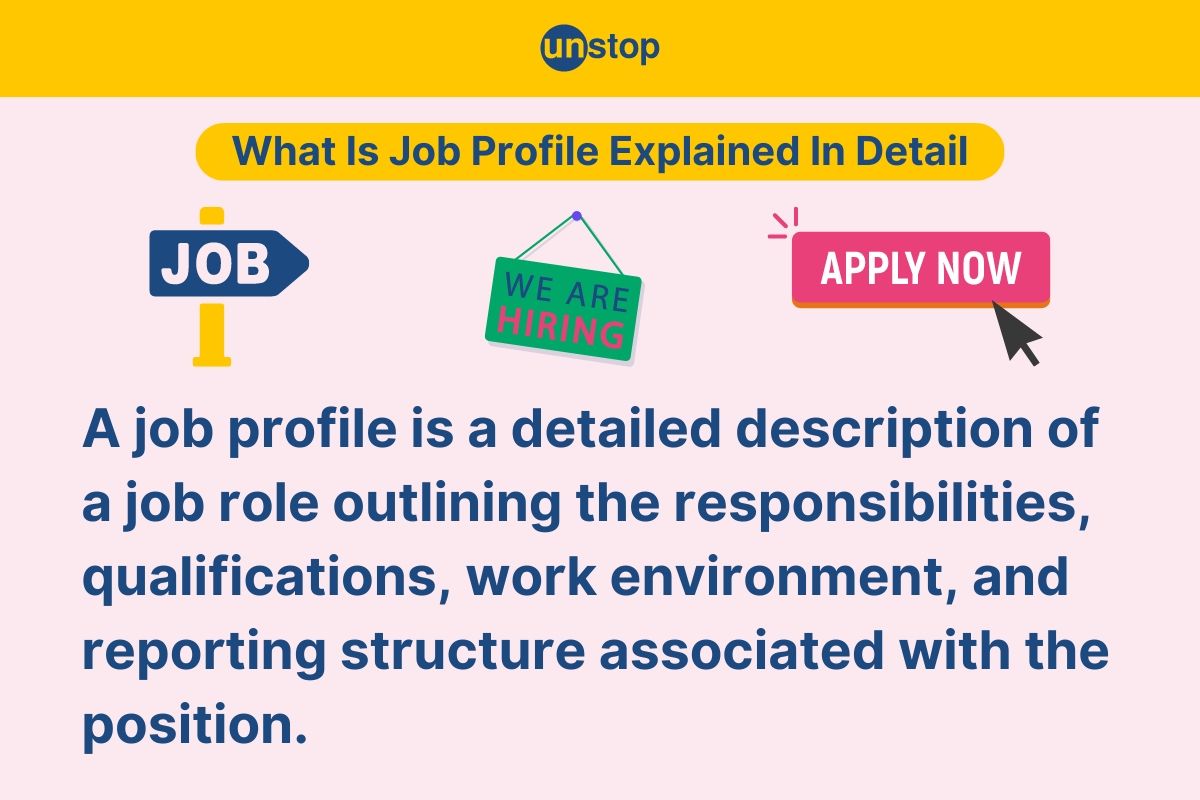
If you've ever wondered what it takes to land your ideal job, look no further. Whether you're a recent graduate or someone looking for a career change, understanding job profiles is essential in today's competitive job market.
In the following paragraphs, we will explore the importance of job profiles, how they can help you identify your strengths, and provide tips on how to align your skills with the requirements of your desired role. If you're prepared to start your quest for the perfect job profile, then get ready for some valuable information! Strap in and brace yourself for insightful tips and tricks.
Meaning Of Job Profile & Purpose
To begin with, let us study the meaning and the purpose of a job profile:
Meaning
A job profile is a detailed description of a job role outlining the responsibilities, qualifications, work environment, and reporting structure associated with the position.
Purpose
The key purpose of a job profile is to attract potential candidates and provide them with essential information about the position. A job profile in a job ad shows the responsibilities, requirements, and company description. It helps employers and candidates figure out if they're a good match.

Key Components Of A Job Profile
When reviewing a job profile, you can expect to find several key components that provide valuable insights into the position. These typically include:
Job Responsibilities
The job profile outlines the specific tasks and duties associated with the role. It provides an overview of what is expected from the successful candidate on a day-to-day basis.
Required Skills & Qualifications
The profile highlights the essential skills, qualifications, and experience necessary to perform the job effectively. This allows candidates to assess their suitability for the position.
Company Description
A well-crafted job profile also includes information about the company or organization offering the position.
Looking for the perfect JOB or INTERNSHIP? Explore hundreds of job roles across multiple domains on Unstop!
Benefits Of Job Profiles For Employers
Let us study the benefits of job profiles for employers:
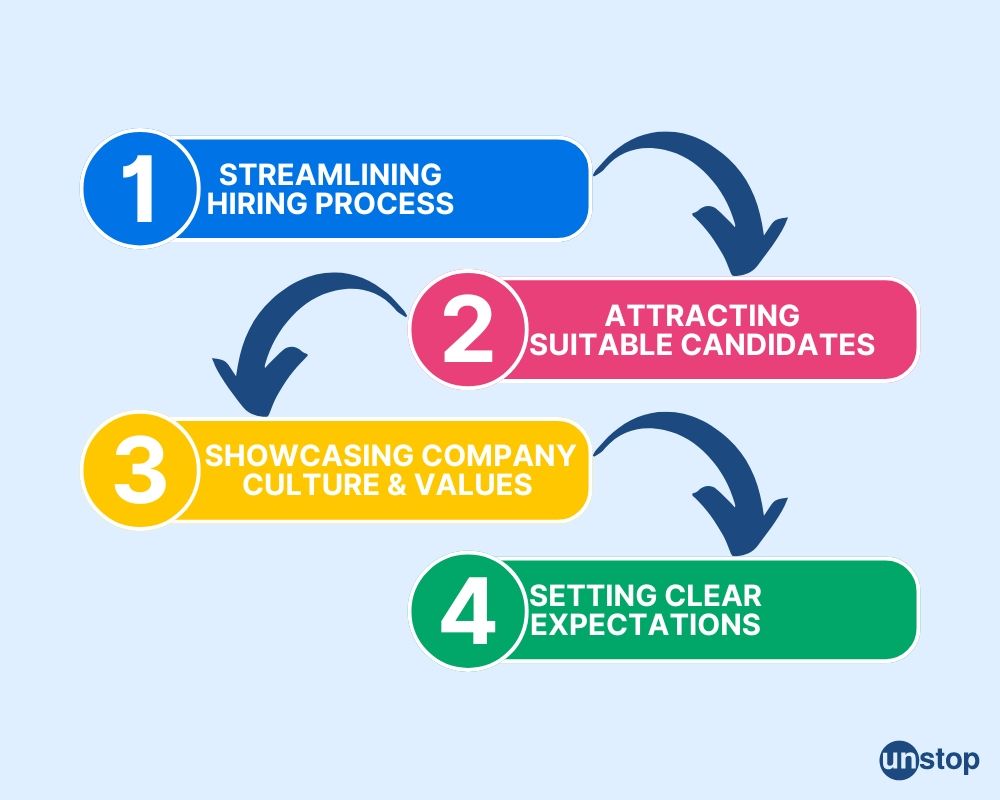
Streamlining Hiring Process
Job profiles play a crucial role in streamlining the hiring process for employers. By clearly outlining the skills, qualifications, and responsibilities required for a specific position, job profiles help employers attract candidates who are well-suited for the role.
Attracting Suitable Candidates
Job profiles help attract the right candidates by giving clear information about the job. This helps potential hires decide if they have the right skills and qualifications. It also increases the chances of finding the right person for the position.
Showcasing Company Culture & Values
Employers can utilize job profiles to showcase their company culture, values, and unique selling points. By highlighting these aspects, employers can attract candidates who share the same goals and values, leading to a more harmonious work environment.
Setting Clear Expectations
By clearly defining roles, responsibilities, and performance expectations, employers can ensure that candidates have a comprehensive understanding of what will be expected from them if they join the organization. This reduces any ambiguity or misunderstandings during the hiring process and helps both parties make informed decisions.
5 Best Tips For Crafting An Effective Job Profile
When it comes to attracting the right job seekers, a well-crafted job profile is essential. To create a concise and informative job profile, consider the following 5 best tips to craft an effective job profile:
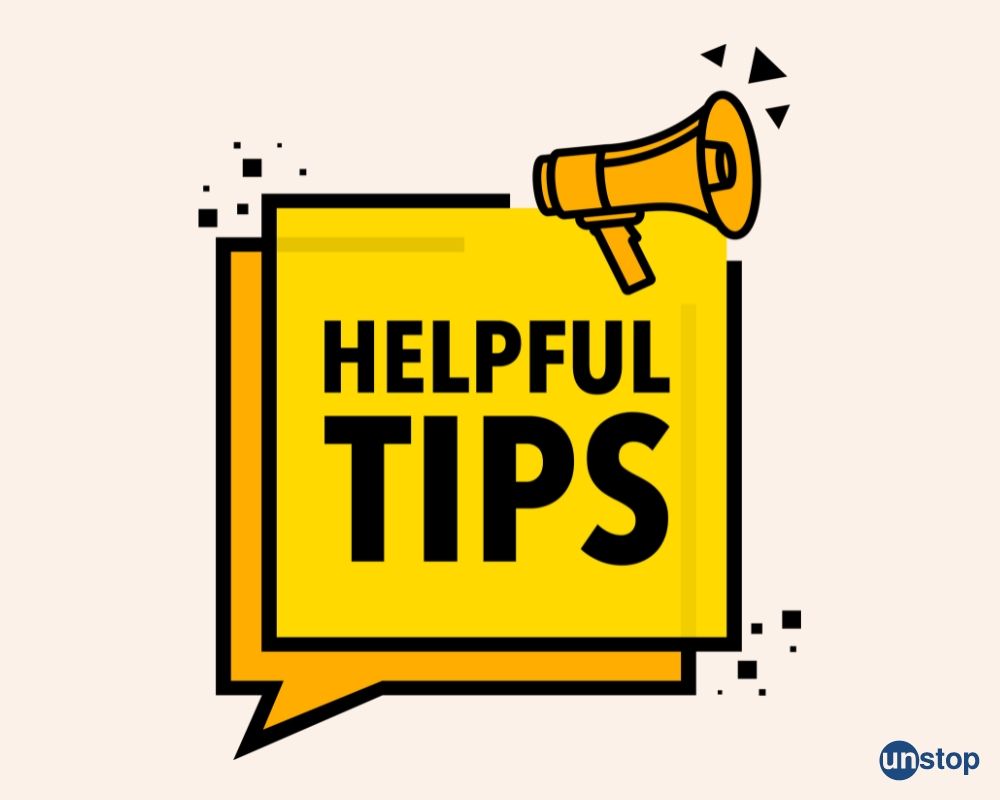
Use Clear & Specific Language
Clearly state the job title, responsibilities, and required skills. Avoid vague or generic terms that may confuse or mislead applicants.
Highlight Key Skills & Qualifications
When looking for the right candidate for the job, it is important to clearly outline the necessary skills, qualifications, and experience. Presenting this information in bullet point format can help job seekers easily identify what is required for success in the role.
Focus on Performance Expectations
Clearly outline the performance expectations for the position. Describe specific goals, targets, or metrics that applicants will be evaluated against.
Research Comparable Job Profiles
Take the time to research similar job profiles in your industry. This can help you identify common requirements and ensure your profile is competitive.
Avoid Unnecessary Jargon
When describing a job profile, it is crucial to present precise details without overwhelming potential candidates with complex industry jargon or technical language that might discourage them.
Common Pitfalls To Avoid In Job Profile Descriptions
Crafting an effective job profile also involves avoiding common pitfalls that can deter qualified candidates from applying. Here are some key points to keep in mind:
Be Realistic About Requirements: While it's important to set high standards for applicants, be realistic about the necessary qualifications and experience. Setting overly stringent requirements may discourage potentially great candidates from applying.
Balance Must-Have vs Nice-to-Have Skills: Differentiate between must-have skills and nice-to-have skills in your job profile. This allows you to prioritize essential qualifications while still considering candidates who possess additional desirable skills.
Provide Clarity on Application Process: Clearly communicate the application process, including any specific documents or materials required. This helps applicants understand what is expected of them and ensures a smooth and efficient recruitment process.
Set Realistic Expectations: Be transparent about the work environment, company culture, and any potential challenges that applicants may encounter in the role. Setting realistic expectations helps attract candidates who are genuinely interested and well-suited to the position.
Job Profile Vs Profile Summary
A job profile and a profile summary are two distinct elements in the job application process. While both provide information about an individual's qualifications and experience, they serve different purposes.
| Job Profile | Profile Summary |
|---|---|
| Description of the tasks, responsibilities, and duties of a specific job role. | A brief overview of a person's skills, qualifications, and experience. |
| Provides detailed information about the job role and what is expected from the employee. | Highlights key qualifications, achievements, and relevant experience. |
| Focuses on specific job-related skills and competencies required for the role. | Summarizes the candidate's professional background and expertise. |
| Tailored to match the requirements and responsibilities of a particular job position. | It can be customized to align with the desired job or career path. |
| Includes specific details about the job title, department, and reporting structure. | Does not include specific job details or organizational information. |
Customizing Profile Summary For Success
Customizing your profile summary can significantly enhance your chances of success in job applications. Here are some tips to consider:
Be concise: Keep your profile summary short and impactful by focusing on key achievements and skills.
Quantify accomplishments: Whenever possible, include specific metrics or numbers to showcase your achievements.
Use action verbs: Start sentences with powerful action verbs to convey competence and proactivity.
Highlight relevant experience: Prioritize mentioning experiences that directly relate to the job requirements.
Update regularly: Regularly review and update your profile summary to ensure it remains relevant and up-to-date.
Summary
In summary, understanding job profiles and their importance in the hiring process is crucial for both employers and job seekers. Crafting an effective job profile allows employers to hire the right candidates by clearly outlining the qualifications, responsibilities, and expectations of the role. Job profiles also help job seekers to better understand the requirements of a position and determine if they are a good fit.
By utilizing job profiles, employers can streamline their hiring process and save time by focusing on candidates who closely match the desired qualifications. To make the most of job profiles, ensure that they are accurate, concise, and well-structured. Use specific language and keywords to optimize your job profile for search engines and increase its visibility to potential candidates.
Frequently Asked Questions (FAQs)
1. What is a job profile?
A job profile is a thorough explanation of the duties, qualifications, and abilities required for a particular job position. It offers a summary of the role and assists potential candidates in determining their suitability for the position.
2. How is a job profile different from a profile summary?
While a job profile focuses on the specific details of a particular job role, a profile summary is a brief overview of an individual's skills, experience, and qualifications. A job profile provides information about the position, while a profile summary highlights an individual's professional background.
3. What are the benefits of using job profiles for employers?
Employers use job profiles to attract skilled candidates by clearly stating the role's expectations and prerequisites. These profiles also aid in assessing applicants based on predetermined criteria and ensuring that their skills align with the organization's needs.
4. How can I craft an effective job profile?
To make a good job profile, start with a clear and short title that shows the role. Give lots of details about the responsibilities, qualifications, and skills needed. Use bullet points to show important points and make it easy for candidates to understand quickly.
5. Why are job profiles important in recruitment?
Job profiles are important for recruitment. They help attract qualified candidates by giving detailed information about the position. This helps potential applicants know what is expected from them, which leads to better hiring decisions.
Suggested reads:
- Biodata For Job Applications | 10 Tips For An Effective Biodata
- High Potential (HIPO) Employee: What Does It Mean & Why Is It Important?
- Laying Off But Not Letting Down: Managing Workforce Reductions With Compassion
- Loud Quitting - What Lies Behind The Noise & How HRs Can Navigate
- Mistakes When Hiring Young Talent: 6 Things To Look Out For
Instinctively, I fall for nature, music, humor, reading, writing, listening, traveling, observing, learning, unlearning, friendship, exercise, etc., all these from the cradle to the grave- that's ME! It's my irrefutable belief in the uniqueness of all. I'll vehemently defend your right to be your best while I expect the same from you!
Login to continue reading
And access exclusive content, personalized recommendations, and career-boosting opportunities.
Subscribe
to our newsletter









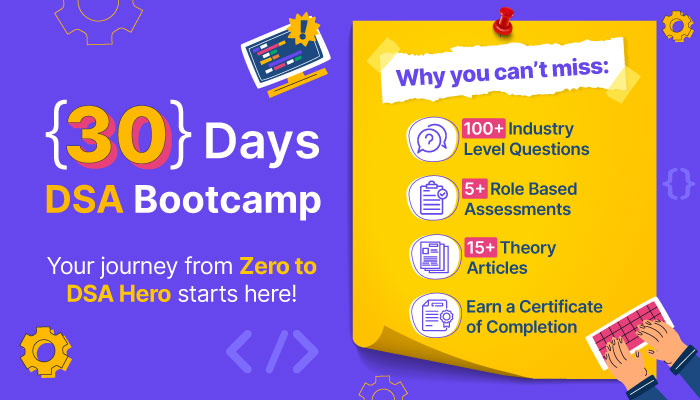



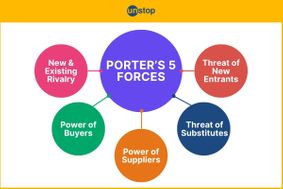
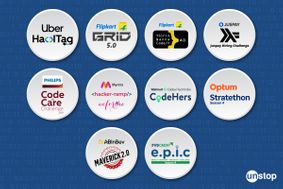


Comments
Add comment